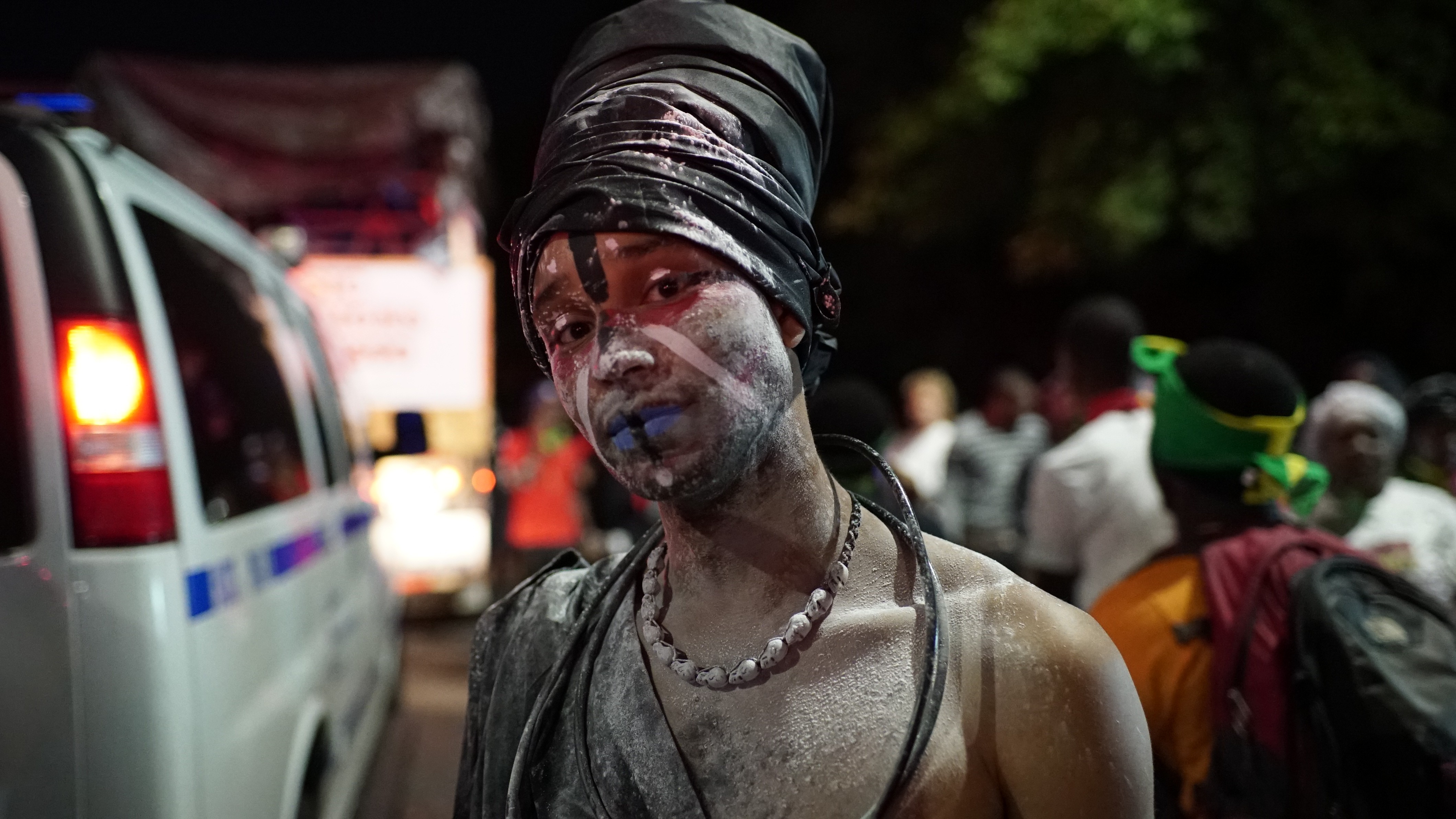Every year in Brooklyn, in the wee hours of Labor Day morning, a sea of otherworldly characters smothered in oil and paint or costumed in devilish masks swarm Flatbush Avenue, willing the sun from its slumber with their clanking steel pan music. The pre-dawn Afro Caribbean street party known as J'ouvert is the raucous prelude to the West Indian Day Parade that happens in the bright summer sun with its own band of masqueraders, who whine down Eastern Parkway to the sound of soca music in fancy feathered headdresses and colorful spandex. The two celebrations are the yin and yang of New York's Carnival celebrations, which turn the streets of Brooklyn into a runway of sorts for revelers, who use fantasy and craftsmanship to represent their West Indian culture through costumes that are both personal and political.
Advertisement
"Masquerading, or 'playing mas' as we call it, is about the freedom to express yourself in the streets," says Donna Dove, the FIT-trained costume designer for Pagwah, one of the most well-known mas bands in New York that plays during J'ouvert. Last year, Pagwah's band members won the top J'ouvert prize for their costumes: all-black berets, knee-length fringe vests, and massive, elaborate straw hats that sprouted from the crown and snaked down revelers' shoulders. Dove, who is originally from Trinidad and has designed for Pagwah the past nine years, says she drew inspiration from the Black Lives Matter movement—evident in the pleather vests and berets that wink at the Black Panther Party's own chic uniform. "Inspiration is drawn from consciousness and awareness of present-day circumstances," she says. But J'ouvert is also about imagination, and the costumes' fantastic flourishes help to tell a more triumphant story about black lives. "You have to understand that to play mas is to tell a story, whether it's of history or experiences," Dove explains.Whether they know it or not, today's masqueraders carry that history as they "chip" or shufflerhythmically down the road. Though New York's J'ouvert has only been a fixture in Brooklyn since the 80s, it is rooted in the centuries-old tradition of Carnival in Trinidad. French settlers who colonized the island in the 18th century celebrated mas but excluded the Africans who had been enslaved. With the abolition of slavery in 1834 came the evolution of Carnival from the society balls of the ruling class to the street festivals of an emancipated people rejoicing in their freedom. With limited resources, Trinidad's new revelers created costumes from colored cloth, tar, and grease. Many of the traditional characters created in early Trinidad society can still be found on the street today in Brooklyn. You'll see "jab jabs," devil-like creatures usually covered in black paint, romping around Flatbush at 4 AM, or maybe a "Dame Lorraine," an exaggeratedly voluptuous woman dressed up to mimic the French aristocracy.
Advertisement
This kind of political satire is a mainstay of New York's J'ouvert in particular, and 2016 provided more than enough fodder. One reveler wore a Hillary Clinton mask while riding a "donkey" with Donald Trump's face. He said that he was "riding this jackass straight into the White House." But the West Indian Day Parade, which follows J'ouvert, presents a stark contrast in costumes. Around 10 AM, the steel pans are swapped for speakers oozing rapid-fire soca beats, and the crowd becomes younger and less clothed. Still, these masqueraders nonetheless see Carnival as a crucial time for self-expression, too. "The Brooklyn Carnival [after J'ouvert] is definitely geared toward a younger crowd," says Rhia Babb, 30, a Brooklyn-based designer originally from Trinidad. Babb's show-stopping designs include all-white headdresses and "back packs" (the plumed collar that adorns the masquerader's shoulders) accentuated by long, beautifully placed pink-and-green feathers and a white bikini dripping in gems. She has created these kinds of masterpieces for Carnivals from Toronto to Bermuda, but in New York, she has mainly worked with Ramajay Mas, one of the bigger bands that play along Eastern Parkway. Like many of New York's designers, Babb eats, sleeps, and breathes Carnival. "In my culture, in my blood, I'm a Carnival baby, so once I go out there, I'm going to enjoy myself to the fullest," she says, noting that the experience is especially rewarding for people who work behind the scenes. "We're the ones losing sleep at night. Because at the end of the day, this is a production. You're putting on a show for a lot of people."
"The Brooklyn Carnival [after J'ouvert] is definitely geared toward a younger crowd," says Rhia Babb, 30, a Brooklyn-based designer originally from Trinidad. Babb's show-stopping designs include all-white headdresses and "back packs" (the plumed collar that adorns the masquerader's shoulders) accentuated by long, beautifully placed pink-and-green feathers and a white bikini dripping in gems. She has created these kinds of masterpieces for Carnivals from Toronto to Bermuda, but in New York, she has mainly worked with Ramajay Mas, one of the bigger bands that play along Eastern Parkway. Like many of New York's designers, Babb eats, sleeps, and breathes Carnival. "In my culture, in my blood, I'm a Carnival baby, so once I go out there, I'm going to enjoy myself to the fullest," she says, noting that the experience is especially rewarding for people who work behind the scenes. "We're the ones losing sleep at night. Because at the end of the day, this is a production. You're putting on a show for a lot of people."

Advertisement
The costumes Babb creates for Ramajay Mas can range from $250 to $1,000 for a one-of-a-kind outfit, which may seem steep, but considering the convenience of staying put rather than traveling to Trinidad, most masqueraders won't hesitate to shell out. "It's home, so it's different," says Felicia Francis, 26, who designs for Boom Mas, another well-known New York band. "It's always a different feeling when you're home, and you can get away from your house and put on a costume and go on Eastern Parkway. You're not spending a bunch of money traveling. You're just in your comfort zone."Francis's family is from Barbados, but she grew up in Brooklyn and got her start in the party scene modeling costumes at Labor Day parties. After she had her son, she decided to try her hand at entrepreneurship and began designing costumes. Boom Mas's theme last year was "Brazilia," and Francis designed a breathtaking blue-and-purple set intricately adorned with body chains and strategically placed gems, inspired by the Cotinga bird, a species found in South and Central America.While New York's Carnival designers tend to have drastically different inspirations—with some rooted in tradition and satire, and others more ephemeral—they share a common bond in designing for a vastly diverse Caribbean community in New York. "I think New York Carnival has a unique personality only because in Brooklyn, there are a lot more people who actually aren't born and raised in the Caribbean," says Babb. With so many rich histories to tap into, though, New York does carry its limits. "In New York, [the people] are not conservative at all, but we are restricted by the Carnival association in terms of what people can wear," Babb says. Dove agrees: "There is a sense of policing in New York that we don't have in Trinidad," she says, but perhaps reflecting that unique hustler spirit in New York, she adds, "Revelers are more free in Trinidad, but we Brooklynites work with what we have."Art by Duane BrutonFollow Amirah Mercer on Twitter.
